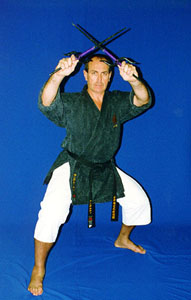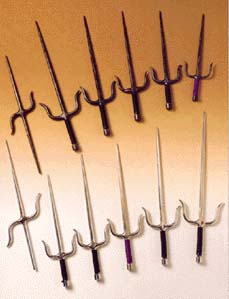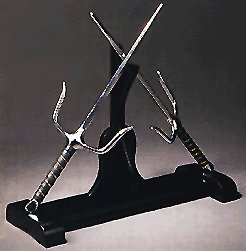|
|||
|
| -Countries |
| -Dictionary |
| -Federations |
| -M.A. Timeline |
| -Number System |
| -Styles |
| -Weapons |
| -Who's Who |
| -Updates |
| -Credits |
| -Stats |
| -Webmaster |
| Sai History
The Rercords from China prove the Sai's original existence although in a much more elongated form. The weapon is metal and of the truncheon class with its length dependent upon the forearm of the user. When held it should be about 3cm longer than the forearm and generally Sai are used in pairs. Advanced Sai uses 3, with one held in the belt
behind ready for, and used for throwing. The tang is of the
Korean The efficient use of the weapon is much reliant on the dexterity of the practitioner with his thumbs, which the tang is balanced and rotated on along with the loosening and tightening of the grip from the small finger for striking and consolidating power. The early use of the weapon makes the user appear stiff and robotic but as the training advances the flow and unity with body movement becomes ever more apparent. Sai is the practice of "Shuto" in empty hand and emphasizes the need for "Koshi no Chikara" (Hip power) and "Suri Ashi" (sliding movement). The importance of body movement and good footwork is ever more apparent as the weapon is of a smaller classification than Bo. Advanced practitioners must learn to throw the Sai, a difficult requirement in view of the weight. The Sai explores the weakness of Bo, thus making Bo-jutsu stronger. This weapon, shaped like a man, was brought into Okinawa by Chinese officials in a trading era. Officer's Chiku and Saji, who acted as both judge and police at the same time, carried Sai in order to protect the King, control crowds, and catch criminals. There was a similar weapon called "Jutte" which was used by police officers in mainland Japan. However, Sai is usually used in pairs with a third sometimes carried as a back up. It is good for both defense and attack. Sometimes it can even be thrown to stab a runaway criminal. Sai implies an ornamental hairpin and it was mentioned in Chinese war tactics book "Bubishi". It has been actively practiced in Okinawa as a martial art for a long time. This technique was handed down to late Grand Master Shinko Matayoshi by Mr. Higa (Gushikawa Tiragawa) who came to Gushikawa village from Shuri.
|


 classification
and the pommel is variant to round, square or multi angled types
much dependant on the emphasis of the makers usage. The basic
holding manner "Honte-Mochi" (Natural) and "Gyakute-Mochi"
(Reverse) is prevalent with basic Sai whereupon the advancement
to "Toku-Mochi" (special grip) is introduced. This
brings the usage and actions of the Sai into the same family
as Tonfa and Kama. The Manji Sai which was made by Shinken Taira
has a half reversed tang looking much like a swastika and a
pointed pommel end denoting Sensei Taira's preference to a stabbing
motion instead of the smashing techniques dominant with the
Tsuujo Sai.
classification
and the pommel is variant to round, square or multi angled types
much dependant on the emphasis of the makers usage. The basic
holding manner "Honte-Mochi" (Natural) and "Gyakute-Mochi"
(Reverse) is prevalent with basic Sai whereupon the advancement
to "Toku-Mochi" (special grip) is introduced. This
brings the usage and actions of the Sai into the same family
as Tonfa and Kama. The Manji Sai which was made by Shinken Taira
has a half reversed tang looking much like a swastika and a
pointed pommel end denoting Sensei Taira's preference to a stabbing
motion instead of the smashing techniques dominant with the
Tsuujo Sai.